




| Palmate Newt (Lissotriton helveticus (Razoumovsky, 1789)) |





|
|
Scientific name: Lissotriton helveticus (Razoumovsky, 1789) Common name: Palmate Newt French name: Triton palmé, Triton helvétique. Order: Caudata Family: Salamandridae Size: 5 to 9.5 cm. Females are slightly larger than males. Habitat: In the aquatic phase, from February to June-July, the Palmate Newt is found in small areas of stagnant or weakly flowing water devoid of fish, ponds, ditches, ruts, small slow streams, with a preference for shaded environments, forests, hedges. In the terrestrial phase, the rest of the year, the Palmate Newt is found in forests, meadows, parks and gardens where it is mostly nocturnal. The Palmate Newt hibernates under stones or stumps close to the place of birth, but also sometimes in water. Food: Aquatic invertebrates and their larvae and insects and their larvae in the terrestrial phase. Reproduction: Reproduction takes place in an aquatic environment. The male deposits a spermatophore on the female and this one collects it in its cloaca. After internal fertilization, the female lays between 100 and 300 eggs which will produce larvae after 2 or 3 weeks. Geographic area: Western Europe, northern Iberian Peninsula, France except extreme south-east, Great Britain including Scotland, Belgium, Luxembourg, western Germany, Switzerland north of the Alps. |
The Palmate Newt has smooth skin. The snout is rounded and the head is speckled brown with a darker band at the eye. In the aquatic phase, the male shows a large caudal crest which ends in a sharp point. The hind legs are black and webbed. The throat is flesh-coloured and not spotted. There is a short filament at the end of the tail. The female is pale brown in colour. The throat is flesh-coloured, not spotted. The belly is pale orange and faintly spotted. The cloaca is whitish. There is a very small caudal crest and a very small dorsal crest. There is often a light dorsal line and a pale spot above the joint of the hind legs. In the terrestrial phase the crests disappear. The males' legs are no longer webbed and there is no longer a filament at the end of the tail. The smooth skin in the aquatic phase becomes slightly grainy in the terrestrial phase. Adult females can be confused with those of the Smooth Newt (Lissotriton vulgaris). The female of the Smooth Newt has a spotted throat but sometimes faintly. There is normally no pale spot above the joint of the hind legs, the cloaca is usually dark in colour, and the underside of the feet bears two light-coloured pads. |
| [To know more about the Palmate Newt] [Next picture] [Top] |
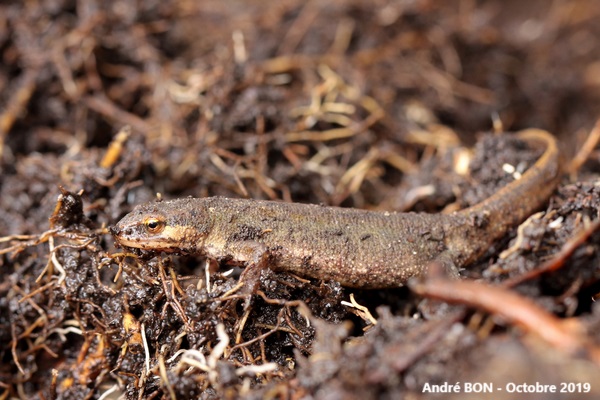
|
It was while cleaning a rainwater collection manhole that I disturbed this newt which, I think, must have been here to hibernate. We are here less than 5 meters from the small pond which adorns my garden and where these newts must reproduce. I carefully moved it to another location, namely my compost heap, hoping not to have disturbed it too much. I think it's a female. I didn't think to look at the underside of the body and the throat, so there is still some doubt between the Palmate Newt (Lissotriton helveticus) and the Smooth Newt (Lissotriton vulgaris). |
| [To know more about the Palmate Newt] [Next picture] [Previous picture] [Top] |
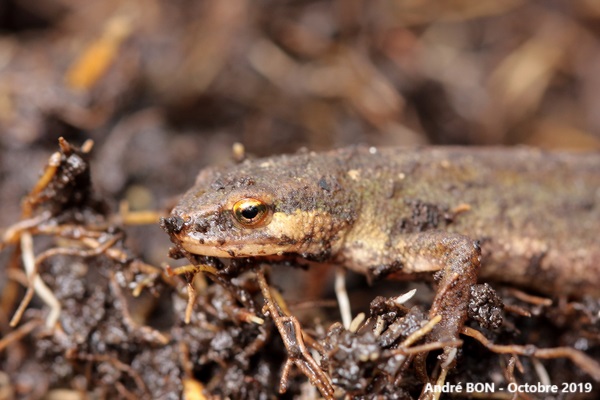
|
Close-up of the head. |
| [To know more about the Palmate Newt] [Next picture] [Previous picture] [Top] |
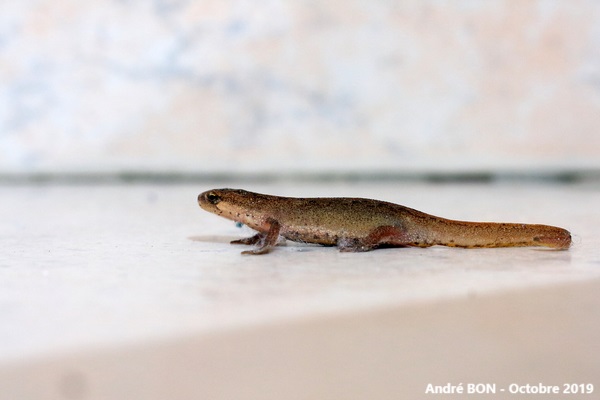
|
Ten days after observing a newt in my garden I was surprised to find this one inside the house. It is very possible that it is the same specimen. I think it is a female. I still do not have a view of the underside of the throat. We can clearly see a small pale spot above the joint of the hind leg which could be an indication for the Palmate Newt. However I am not sure that this criterion alone is enough to eliminate the Smooth Newt so I leave the identification to the genus only. |
| [To know more about the Palmate Newt] [Next picture] [Previous picture] [Top] |
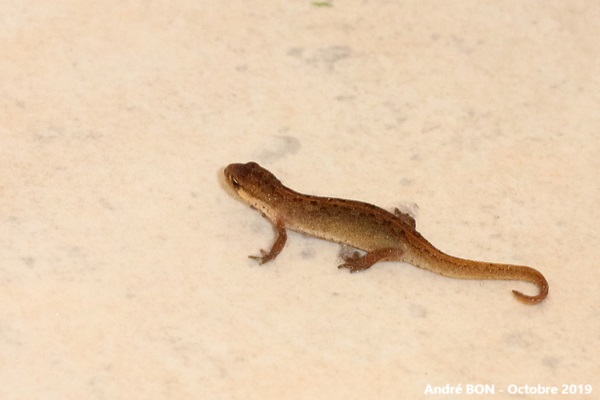
|
I'm not sure the house is the best place to overwinter, so I carefully steered this newt toward the exit door. |
| [To know more about the Palmate Newt] [Previous picture] [Top] |
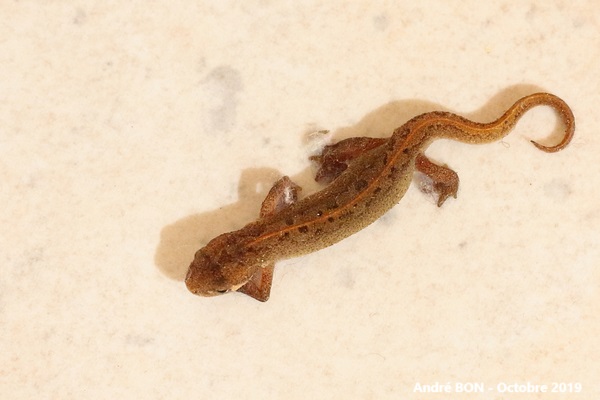
|
One last photo before returning outdoors. We can clearly see the clear dorsal line. |